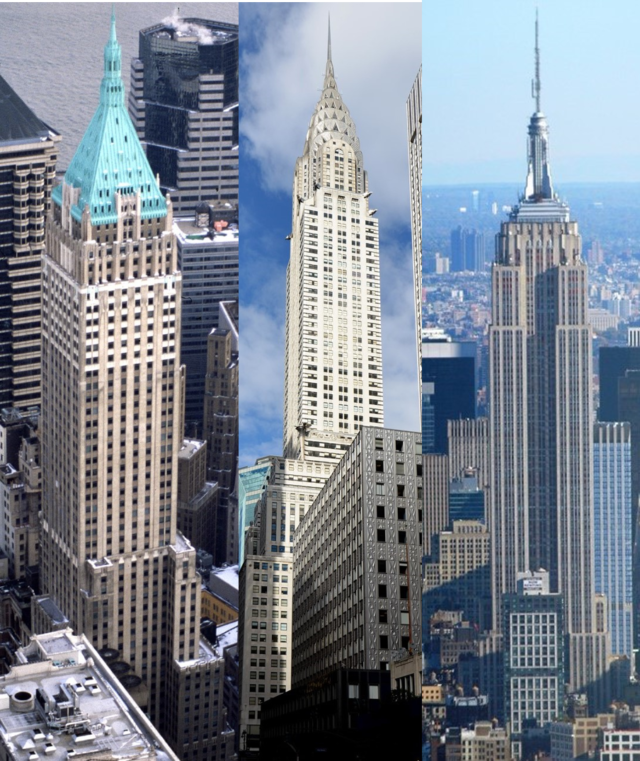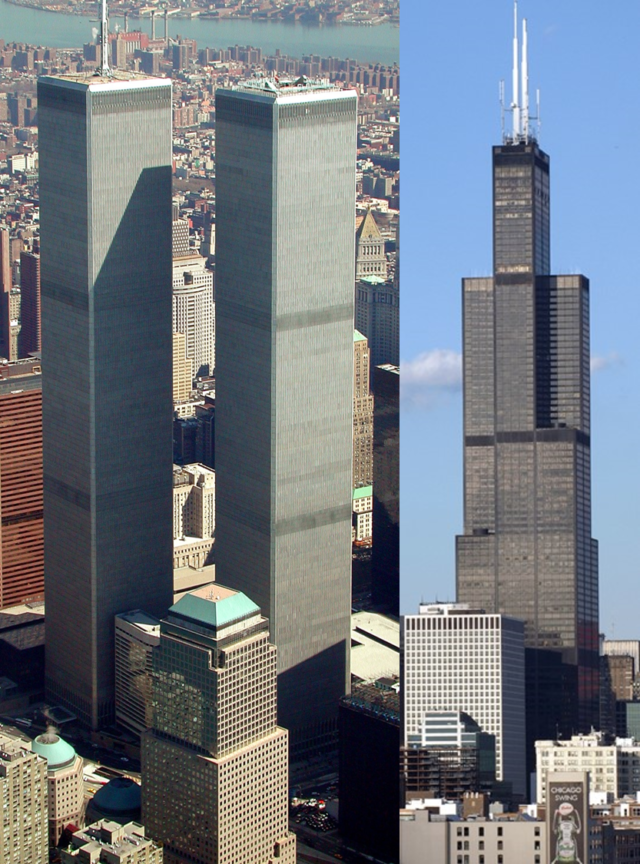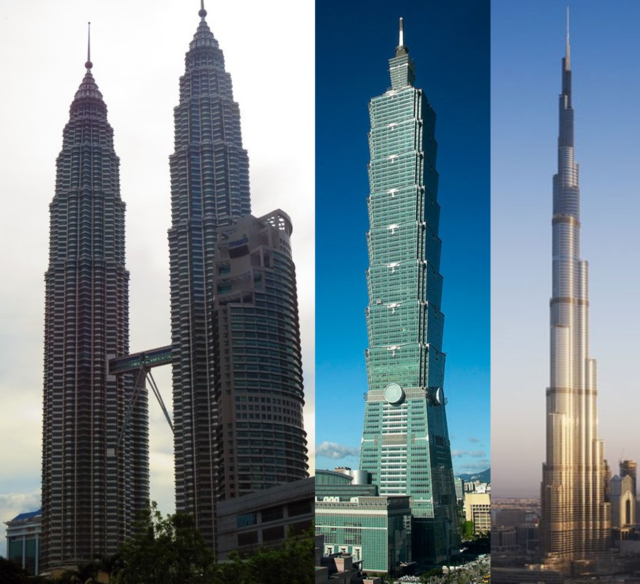Jason M. Barr January 28, 2019
Note this is Part III of a series on the economics of skyscrapers. The rest of the series can be read here.
When we look at the world’s tallest buildings, we can’t but help think they are too tall—the product of greed and vanity. But this is too simplistic. In a previous post, I proposed nine different theories as to why supertall buildings might rise so high (though there certainly may be more). I would argue, however, that these theories can be categorized into one of four groups. First can be called “good economics”; the second “bad economics”; the third is “selfish motives”; and the last is “urban growth strategy.”
Theories of “Too-tall” Height
Let’s start with “good economics.” By this I mean that the constructed height of a supertall building reflects the best balance of the revenues and costs. That is, a supertall building may simply be the result of matching supply with demand at a particular location. However, at times, forces may be at work to artificially raise the price of building space, or artificially lower the cost of construction—hence “bad economics.” Developers are maximizing profits, but the income or costs deviate from the correct values because of illegal or unsustainable reasons.
The “selfish motives” theories include many of the typical beliefs about supertall buildings—they are built by greedy developers eager to show off or claim an “ego prize,” or they are built by dictators seeking to legitimize their rule. In this case, developers are adding floors above the (good or bad) economic height for non-economic purposes. Lastly, supertall buildings are often built as a means of sparking urban growth or to put a city on the “economic map.” By building a landmark, governments or developers seek to increase foreign direct investment, tourism, or employment opportunities.

The Evidence for Record-Breaking Skyscrapers
But the question remains: what is the evidence for the various theories? Regarding the world’s record-breaking buildings, a key problem is the very small sample size—only 12 buildings since 1890 have held the record. Thus, a case-study approach that looks at the historical record, including from books, newspapers, and trade publications, seems reasonable.[1] While case studies do not prove things conclusively, they do suggest some theories over others.
The Bank of Manhattan Trust Building
The Bank of Manhattan Trust Building, at 40 Wall Street, was the first of three Manhattan skyscrapers to break the world record during the Roaring Twenties. At 927 feet (283 meters) it surpassed the Woolworth Building (792 feet, 214 meters), which held the record since 1912. It was a speculative venture by the Starrett Brothers (who were also the general contractors), an investment group lead by G. L. Ohrstrom and the Bank of Manhattan itself, who was to occupy seven floors. Evidently, the original designs in 1929 called for a 47-story structure; but were then changed to 60 stories, and finally, architect H. Crain Severance drew up plans for 67 stories.
Denial
Even though the height changed over the course of the project, it’s worth pointing out that in 1929, a 47-story skyscraper was deemed appropriate. That is to say, without any competition in mind, the economic height was nearly 50 stories. Even in 1930, the bank saw rising profits from the year before. But the reasons surrounding the changes in height are a bit unclear. Architectural historian, Christopher Gray suggests that the plans were changed after Walter Chrysler announced his building, designed by William Van Alen. Yet two other bits of evidence also suggest that the team lacked the fortitude to go all the way. Gray writes,
Van Alen was the subject of many interviews and articles, but no one, it seems, interviewed Severance, the second-place finisher, as to his thoughts….Faith Hackl Steward, Severance’s daughter, says he “never made any remark about it,” except to say that “there really wasn’t any race.”
On October 20, 1929 (some seven months before the opening of the Chrysler Building), the New York Times reported,
When his attention was called to the suggestion that the 40 Wall Street Corporation, in which Starrett Brothers and G. L. Ohrstrom, investment bankers, have a large interest, was engaged with the Chrysler Corporation in a race to erect the world’s tallest building, Mr. Starrett said his company was not competing for height supremacy in building and added that he thought the Bank of Manhattan Building was “too high now.”
What seems to have happened was that some of the investors were pushing for a taller building, but there were only certain lengths to which they willing to go.
The Chrysler Building
It is clear, however, that Walter Chrysler wanted the world’s tallest building, when, in 1928, he announced his intention to build a 68-story skyscraper (but eventually topped out at 77 stories). But again, it’s important to keep in mind that the economics were in Chrysler’s favor. His building was a block away from the hypothetical project of Clark and Kingston, who, after crunching the real estate development numbers, determined that, in 1929, a 63-story structure was the profit maximizing one. Chrysler’s speculative project was in the heart of the booming midtown district near Grand Central Station. For Chrysler and Van Alen, grabbing the record after adding the chrome spire amounts to a cheap (that is, low-cost) trick.
In short, the cases of Bank of Manhattan Trust and the Chrysler Buildings show that multiple motives are supported: Economics, Competition, and Ego. But economics needed to be present to pay for the ego.
The Empire State Building
The evidence also supports the idea that the developers of the Empire State Building—John J. Raskob and Al Smith—wanted the world’s tallest building because Raskob considered Chrysler a business rival.[2] But the story, of course, is more complex. First, the Empire State Building sits on a lot that is about 91,000 square feet. This is an even larger lot than the one Clark and Kingston used for their exercise, which was about 84,000 square feet. The bigger the lot, the more favorable are the skyscraper economics.
Second, while the neighborhood was mostly retail, warehousing, and loft buildings, Raskob and Smith intended their project to also be used for “placemaking.” They were betting on the fact that their iconic structure would lure more Class A office space to their area. In short, the Empire State Building offers support for several theories: Economics, Placemaking, and Ego.

The Twin Towers
In the 1960s, business leaders were worried about lower Manhattan’s future, as the district and port had fallen on hard times. Thus was born a plan to create the World Trade Center site to revitalize the neighborhood.[3] Ultimately the project was led by the Port Authority of New York & New Jersey (PA), an independent, interstate government agency established in 1921 to oversee and rationalize port operations in the region.
For the first time in the city’s history, the world’s tallest building would be financed and built by a governmental organization. During the 1960s, slum clearance and urban renewal were all the rage. The Word Trade Center project fit right into that mold. Evidently, once the PA took control, the marketing team suggested that constructing the world’s tallest buildings would be good advertising for the site.
In short, the evidence suggests multiple theories: Placemaking, Urban Growth Strategy, Advertising (though I can’t rule out the ego of PA president, Austin Tobin).
The Sears Tower
Today, Sears is on the brink of failure; yet another victim of internet commerce. But in the early 1970s, Sears, Roebuck and Company, headquartered in Chicago, was the largest retailer in the world (like Woolworths before it). In 1969, it enjoyed profits of $441 million from $8.9 billion of revenue. Sears had more than 355,00 employees worldwide.
The Sears (today the Willis) Tower was announced 1970, and completed in 1973. At 110 stories it beat out the Twin Towers to become the world’s tallest building. But we can’t say for sure that Sears and its CEO, Gordon M. Metcalf, were engaged in direct competition with the Port Authority. What we can say is that Metcalf was eager to have a new headquarters to consolidate Sears’ staff, which were scattered throughout the city. The company estimated that it would eventually require two million square feet of building space. Sears was able to acquire a large lot of 129,000 square feet on the west side of Chicago’s central business district. An iconic structure would likely draw more companies and workers to the neighborhood. As reported in the New York Times,
The area is one that is experiencing what real estate men like to call a renaissance. New office buildings are shooting up on and around Wacker Driver. “Wacker Drive is becoming the Park Avenue of Chicago,” Mr. Rubensten [a real estate broker] said enthusiastically.
Denial
Not unlike the Bank of Manhattan Building, Sears downplayed the idea of height competition.
“The question then was whether to shorten the building or reshape it and maintain the height,” Mr. Dunlap [an architect at SOM] said. “We kept the height, for reasons of proportion, and aesthetics. There was some mention that it would be nice to have the world’s tallest building. But the idea of a space race is silly.” (NY Times, Oct. 18, 1970).
Theories supported: Economics and Placemaking.

The Petronas Towers
The Petronas Towers, headquarters of Malaysia’s state oil company, were completed in 1998, as the centerpiece of Kuala Lumpur City Center, a 100-acre, government sponsored project. The neighborhood and towers were part of a larger program of infrastructure investments, initiated by Prime Minister Mahathir Bin Mohamad. The government was seeking to diversify and modernize the economy, which was dependent on the sale of commodities, such as palm oil, rubber, tin, and crude oil.
Again, the boundary between the ego, economics, and urban growth strategy is not clear. But the goal was to put the city of two million people “on the map.” Of course, critics complained the buildings were too tall. But many saw them as a source of local pride. As the New York Times wrote in 1996,
But supporters say the symbolism itself is worth the cost of construction. “The twin towers are a symbol of Asia’s dynamism and growth,” said Razak Baginda, executive director of the Malaysian Strategic Research Center. “The towers will do wonders for Asia’s self-esteem and confidence, which I think is very important, and which I think at this moment are as the point of takeoff.”
The structures were also designed to lure high-tech firms. In 2003, the New York Times reported,
The Petronas towers have also been designated a distant spur of the Multimedia Super Corridor, Malaysia’s answer to Silicon Valley…Not surprisingly, the list of tenants in Tower 2 includes some of the biggest names in technology…Microsoft occupies two floors, the 29th and 30th….The towers’ biggest draw, however, is not fiber optics, tax incentives or discount cappuccino. “The best thing about working here is status,” said Mr. Kuhan from Asia Telecom. “People look at you differently.”
Theories supported: Economics, Urban Growth Strategy, and Placemaking.
The Taipei 101
National pride is another element of skyscrapers. Residents are eager to use them to convey their independence and command over resources. The Taipei 101 appears to be a combined case of economics, urban pride, perhaps with some ego thrown in. Completed in 2004, the structure was promoted by Chen Shui-bian, the mayor of Taipei in the 1990s, and who went on to be Taiwan’s president. He was eager to have a skyscraper built in a newly-planned neighborhood close to City Hall. Working with one of Taiwan’s wealthiest developers, the two conceived of, and developed, the project. Evidently, the first plans had the building only at 66-stories, but then the election of Chen to the presidency drove them to increase the height. The New York Times reported in 2004,
As with other very tall buildings in Asia, the construction of this one is as much about politics and pride as commerce. “As the world’s highest building, Taipei 101 will attract attention to Taiwan’s excellence, and carve ‘Taiwan first’ in the minds of people around the globe,” President Chen Shui-bian said….
Theories supported: Economics, National Pride, Ego.
Burj Khalifa
Finally, is the Burj Khalifa, which opened in 2010 at 828 meters high. It too was part of a larger planned neighborhood within Dubai. By constructing the world’s tallest building, the UAE. government was seeking to promote its strategy of economic diversification, away from its dependence on oil. In the words of Mohamed Ali Alabbar, Chairman of Emaar Properties:
When we developed Burj Khalifa, we had a clearly articulated vision of not just delivering an icon that underlines the ambitions and spirit of global collaboration that defines Dubai, but also to maximize the value of the land by creating a truly “vertical city.” Burj Khalifa is at the heart of Downtown Dubai, our 202-hectare megadevelopment, and it adds incremental value to the destination.
New York on the Gulf
Bigger. Brighter. More outlandish. Construction-fevered Dubai is almost Gatsby-esque in its audacious thirst for reinvention. This once-sleepy port of pearl traders and pirates is gunning to turn itself into one of the great capitals of the postmodern world.
If Americans pushed west to manifest destiny, the Emirates are pushing into the sky. There is a vague consensus here that great cities arrange themselves around ambitious architecture, and Dubai is determined to outdo them all. You feel it when you drive down the highway, eyes assaulted by a string of quixotic slogans: “The earth has a new center.” “History rising.” “Impossible is nothing.”
Theories supported: Urban Growth Strategy, Placemaking, Ego.
What Does It All Mean?
Based on these case studies, what can we conclude? First, we see evidence for several theories, from pure economics, to urban growth strategies, to pride–both personal and civic–to ego and competition. Second is that money must be available for these large projects. But where the money comes from varies over time and space. Early projects were privately financed, while more recent projects are financed or subsidized by governments. Nonetheless, all these skyscrapers were built in major global metropolises with rapid economic and population growth.
Since the Twin Towers (but excluding the Sears Tower), the norm has been for the world’s tallest buildings to be part of a larger urban and national economic development plan. The buildings are centers of newly-created neighborhoods, and meant to enhance feelings of national pride and create iconic structures that advertise the city. The extent to which the world’s tallest buildings are built by autocrats is not clear. The United States, Malaysia, and Taiwan and are democracies; while the UAE and Saudi Arabia (which is constructing the next record breaker) are not.
Spillovers
Whether the structures directly pay a reasonable return on investment is often beside the point if they succeed in generating wider forms of economic growth and well-being. To my knowledge, no study has tried to measure the spillover benefits that accrue from these soaring towers.
And there is something else to consider. By building the world’s tallest building, it extends the limits of human technological knowledge, which can generate unintended benefits applicable in other areas of our lives more broadly. This will be the subject of a future post.
Continue reading. The rest of the series can be read here.
—
[1] Another method is to collect a larger data set on skyscrapers more broadly and perform a statistical (regression) analysis that looks at the effects of one or more variables on skyscraper heights or counts, holding other important variables constant. For this post, since I’m focusing only on the record-breakers, I will use the case-study method and leave a discussion of statistical results for a future post.
[2] My understanding of the history of the Empire State Building is based on John Tauranac’s book, The Empire State Building: The Making of a Landmark.
[3] My sources for this section are Eric Darton’s (1999) book, Divided We Stand: A Biography of New York’s World Trade Center, and Angus Gillespie’s (1999) book, Twin Towers: The Life of New York City’s World Trade Center.
[…] Note this is Part IV of a series on the economics of skyscrapers. Part I can be read here, Part II here, and Part III here. […]